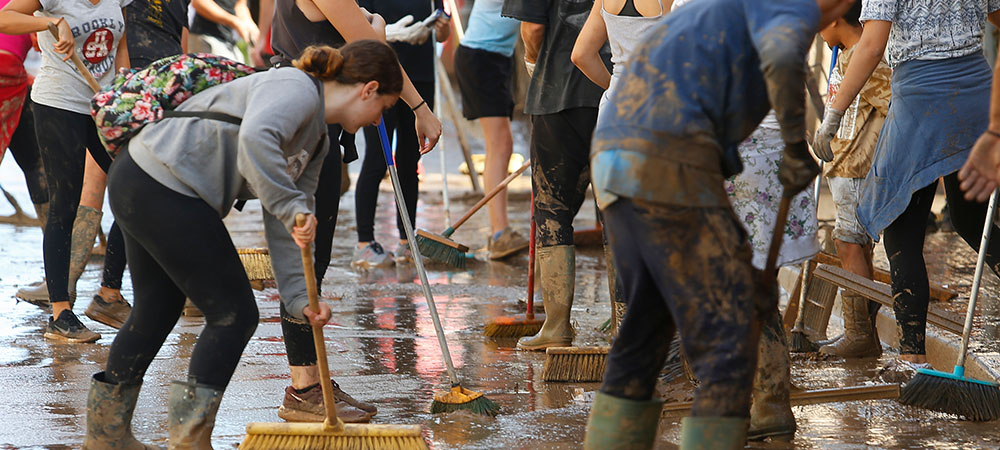 Teens help clean up debris after flash flooding in Mallorca, Spain. Photo Credit: Zixia, 2018.
Teens help clean up debris after flash flooding in Mallorca, Spain. Photo Credit: Zixia, 2018.
Implications for Public Health
Youth involvement in readiness and response improves resilience. Approaches that enlist and engage children in age-appropriate disaster risk reduction activities should be part of preparedness actions.
Many people know that disasters can profoundly affect children. What is less known is the impact that youth can have in building disaster resilience. Youth are a major part of any community and, as such, they endure many of the same disaster repercussions that others experience. Rather than being held powerless, youth can and should contribute to community readiness, response, recovery, and resilience.
While youth vulnerability to disasters is well established, their involvement in readiness and response has received relatively little attention, even though youth who are informed and engaged are better able to protect themselves and others during a disaster. Those involved in disaster planning likely realize that children have special needs during such events, but they should be encouraged to see youth as potential resources that are there to help. The benefits of engaging youth before, during, and after disaster not only strengthen the community, but also have advantages for children and their families.
Youth develop through involvement with others and they need opportunities to participate in age-appropriate activities that are meaningful. Meaningful participation is best fostered through experiential, rather than abstract, learning. Resilience-building activities that allow youth to practice principles and techniques and take part in problem solving are preferable. Such activities might include creating identification cards with local contact information, preparing plans to help ensure pets are protected during a disaster, and participating in local disaster drills. Because community resilience requires deliberate collective action, youth activities should promote purposeful collaboration such as using teams, establishing measurable goals and objectives, and identifying benchmarks to assess progress. The more involved youth are in designing activities and in establishing and measuring goals and objectives, the more likely they are to assume a degree of ownership in the process. This promotes a sense of belonging, commitment, and a feeling of accomplishment and empowerment.
Adult involvement in resilience-building activities for young people is necessary to the extent that youth benefit from direction and validation as they explore new undertakings. Adults can transmit values, history, and social expectations; serve as a resource for information; and help children connect to community leaders and networks that allow them to achieve their goals. Adults can also be influential role models for communication, trust, sharing, and critical thinking. Ideally, adult interaction with these youth efforts will help build relationships that recognize the strengths and needs of one another and that consider and appreciate alternative views.
Beneficial outcomes for both youth and their communities depend, in large part, on the activities they are encouraged to participate in and on the guidance of supportive adults. Youth must be cognitively and socially ready to participate in resilience activities and adults must provide the resources and support youth need to be successful. Tasks and projects consistent with developmental and socio-cultural expectations can foster enthusiasm as youth confront new challenges and acquire new skills. For example, even young children can contribute to the creation of family communication plans and they can help develop and deliver safety messages.
The viability of youth engagement in building community resilience—and the potential benefits associated with it—are theoretically grounded in literature on child development, youth programming, and resilience. Evidence can be found in descriptions and evaluations of a variety of youth programs and in youth contributions to social movements.
Tools have been developed to improve community resilience by enlisting community member participation in preparedness. The Communities Advancing Resilience Toolkit (CART) offers a path to building community resilience by encouraging team members to share information, skills, and resources; communicate; and learn from the experience of working together. CART teams conduct assessments, create community narratives, engage in problem-solving, identify goals and actions, and implement and evaluate selected actions.
While it was initially developed for use with adult groups, CART can be easily adapted for youth. Early field testing has suggested such adaptations can be successful—for instance, the CART Assessment Survey provides an entry point for youth engagement and skill building for youth groups interested in learning about their community. Youth can be involved as a sample to be surveyed and/or they can do the surveying. They can also learn about their community and community resilience by analyzing and interpreting survey findings. The survey instrument addresses five domains of particular importance in community resilience:
- Connection and Caring (illustrated by qualities such as relatedness, shared values, participation, support systems, and equity)
- Resources
- Information and Communication
- Disaster Management (including prevention and mitigation, preparedness, response, and recovery)
- Transformative Potential (expressed through critical reflection, strategic planning, skill building, and collective action)
Even though, and because, they are particularly vulnerable to disasters, youth should be engaged in readiness and response. Not only do youth and their communities benefit from enhanced community resilience, youth can benefit developmentally from participation in disaster mitigation, preparedness, and response activities. Communities have a responsibility— as well as vital reasons—to involve them.
Suggested Tools
Youth Preparedness Catalog
Federal Emergency Management Agency
Catalog published by FEMA of youth disaster preparedness programs, curricula, resources, and activities.
Community Advancing Resilience Toolkit
Terrorism and Disaster Center at the University of Oklahoma Health Sciences Center
Toolkit outlining resilience-building process and providing support tools that can be used for youth engagement and skill building.
For a list of all the tools included in this special collection, visit the Children and Disasters Tool Index.
Betty Pfefferbaum is the George Lynn Cross Research Professor Emeritus in the department of psychiatry and behavioral sciences in the College of Medicine at The University of Oklahoma Health Sciences Center in Oklahoma City, Oklahoma. She is internationally recognized as a leader in child disaster mental health.